Ted and I visited the Parthenon replica in Nashville, TN many years ago; now we’ve seen the real thing atop The Acropolis in Athens, Greece.
Due to thunderstorms and lightning, The Acropolis opening was delayed for two hours on the day of our visit. It’s a popular tourist site, tickets are required to enter, and naturally, everyone with a ticket for the day wants to get in, so when we arrived at our scheduled 9:30 a.m. ticket time, there was a long, backed-up line. Ticket sales to The Acropolis are capped at 20,000 per day, and I’m sure they were sold out, in spite of the rain. It took over an hour just to reach the ticket gate where we could finally head for the top of The Acropolis. I wonder what it was like before ticket sales were capped at 20,000 visitors per day.
An acropolis is simply the highest hill in a city, but The Acropolis in Athens is capitalized and referred to as “The Acropolis” because it’s such an important site. Truth time: The Acropolis is really the second highest hill in Athens, but it was chosen as the site for the Parthenon because there was a spring on the hill—something that was lacking on the highest hill, the real acropolis.
There are several buildings atop The Acropolis in Athens, the most famous of which is the Parthenon, originally a temple dedicated to Athena, an ancient goddess and the patroness of Athens. Temples were usually built on the acropolis because it was believed the gods liked to live there, but the top of the highest hill is a good defensive position too, so the Parthenon also served as a fortress, as well as a treasury. Later, the Parthenon was used as a Christian church, and after that, as a mosque.
Given the excavations Ted and I have seen in Israel, Egypt, Türkiye, and Greece, I think it’s safe to say there’s a lot of rock in this part of the world. (There are a lot of earthquakes too, given all the ruins we saw of cities destroyed by earthquakes.) Walkways are often made with paving rocks, which become very slippery when wet. To reduce pedestrians’ risk of slipping and falling, the paving rocks sometimes have wedged holes in them.
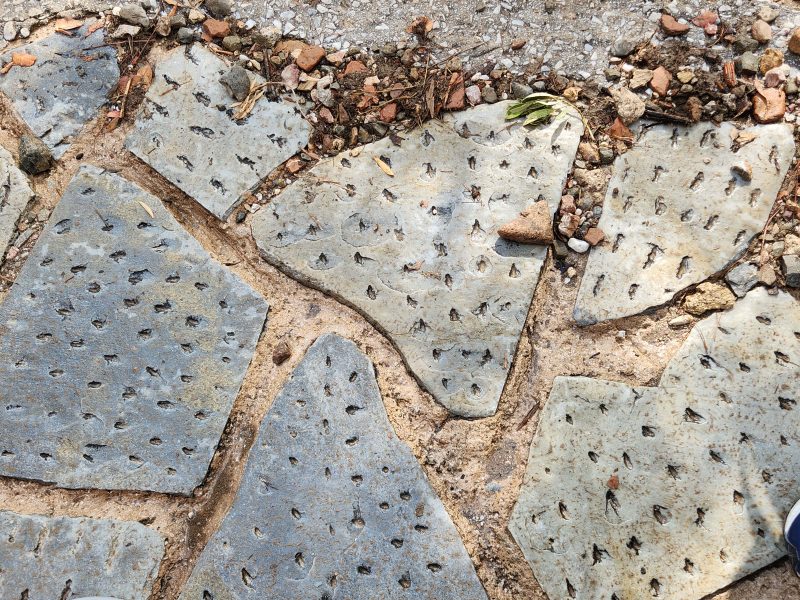
Surprisingly, that really helps, and we were grateful for those holes as we inched our way uphill to the ticket gate in a light drizzle. Along the way, we had our first view of the Parthenon. It was definitely a thrill.

After passing through the ticket gate, we began our upward trek to the top of The Acropolis. The people you see in the photo below are not eagerly surging up the stairs to the top of The Acropolis; they are moving in slow motion. The way to reach the top of The Acropolis is to: (1) Climb up a step or two; (2) walk between the guide ropes across the wide staircase (65-75 feet?) to the opposite side of the stairway; (3) repeat this zigzag pattern until you reach the top of the 80 steps and arrive at the grand entrance—the Propylaeum—on the plateau of the rock. Allow at least one hour to complete the climb at the pace of the hundreds of people ahead of you.
While you are going uphill, the same number of people are doing the same thing between the same guide ropes, but in the opposite direction because they are going down The Acropolis. It’s kind of like being at Disney World, only far more crowded because two lines are moving in opposite directions within the same space. It was hard to enjoy the view on the way up or down because we had to watch our feet to avoid stumbling down a stair or bumping into someone else and causing them to stumble. Do not consider stopping along the way. You will probably be trampled or pushed aside.
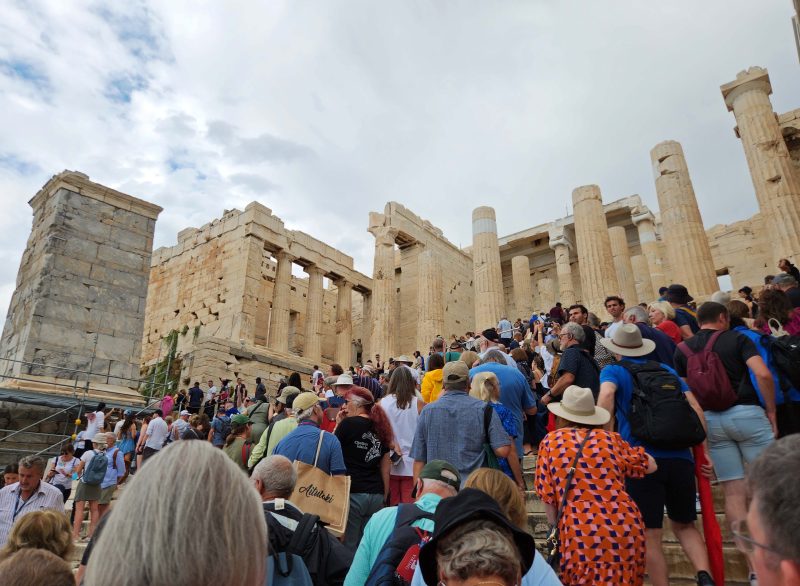
As we were climbing the hill on the pock-marked stones (photo above), we could see the exterior of the ancient Acropolis theater (left photo, below). From the top of The Acropolis, we could look into the theater (right photo) where we saw a crew preparing the venue for a weekend concert. They really built these ancient theaters to last. In most of the ruins we’ve visited, the theater still stands in recognizable form and is still used for concerts and other events. I guess the theory is, “Why build a new one if the old one still works?”

One of the buildings at the top of The Acropolis (shown below) is theTemple of Athena, the patroness of Athens and the goddess of wisdom, handicraft, and war.
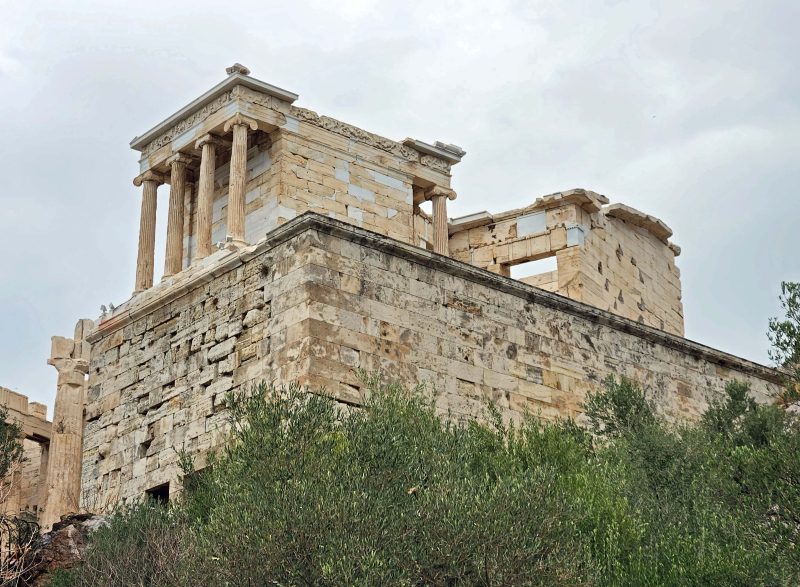
At the top of the 80 steps, we were greeted with the pile of rubble pictured below that used to be the Propylaea—a building complex that functioned as the monumental ceremonial gateway to The Acropolis.

From the top of The Acropolis, we had a beautiful 360-degree view of Athens and the Aegean Sea.

Another of the buildings at the top of The Acropolis is pictured below. It’s the Temple of Erechteion, a mythological king of Athens. The temple is famous for its detailed design. If you look closely (or zoom in), you’ll see that the pillars of the left portico of the temple are statues of the caryatids—six maidens representing the women of Caryae who were doomed to hard labor because their city sided with the Persians during their second invasion of Greece in 480 BC. In this case, their hard labor requires them to support the roof of the portico forever—or until an earthquake knocks it down.

I saved the best for last: the Parthenon. This 2,500-year-old structure (completed circa 438 BC) is the most recognizable building of Greece’s golden age. With the cooperation of the Greek city-states, the Parthenon was completed in only nine years. The building was intended to be the chief shrine to Athena. It also served as the treasury for the Delian League, a confederacy of Greek city-states whose purpose was to form a military alliance to protect Greece from the Persians. Athens, the strongest city-state, pledged its massive navy to protect all members unable to protect themselves. Raise your hand if you think that sounds similar to NATO.
A 2,500-year-old building has a lot of history, so let’s jump roughly 2,100 years ahead of its completion to the Morean (Ottoman) War and the 1687 siege of The Acropolis by the Venetians. The Venetians bombarded the Parthenon with cannon fire, striking the western façade alone with approximately 700 cannonballs. The Ottomans had been using the Parthenon as an ammunition dump and, not surprisingly, the barrage of cannon fire caused the stored gunpowder to explode, severely damaging the center of the Parthenon, destroying most of its walls, and leaving nothing of its roof. Over time the building gradually collapsed, and the last pillar fell in 1852.
In 1975, the Greek government began a large-scale project to restore the Parthenon. Previous restoration efforts damaged much of the stone, and about 50 percent of the original architectural decoration is lost. Greek structural archeologists consciously decided not to completely rebuild the Parthenon, but to restore it to an earlier state as much as possible. Nearly 50 years after it began, the restoration project continues.
The scaffolding required for the Parthenon reconstruction project detracts from its appearance, but the building is huge and very impressive. You can get an idea of its scale by looking at the people in the photo on the right, below. The Lincoln Memorial in Washington, D.C. was modeled on the Parthenon in Athens, and obviously, so was the replica in Nashville, TN. 😊

Before Ted and I navigated our way down the crowded stairway (looking only at the back of the person ahead of us and at our feet to keep from stumbling) I took this picture of the Philopappos Hill Monument, a Greek mausoleum, dedicated to the aristocratic and well-connected first-born son of a Greek prince. It’s the pillar at the top of the tree-covered hill.
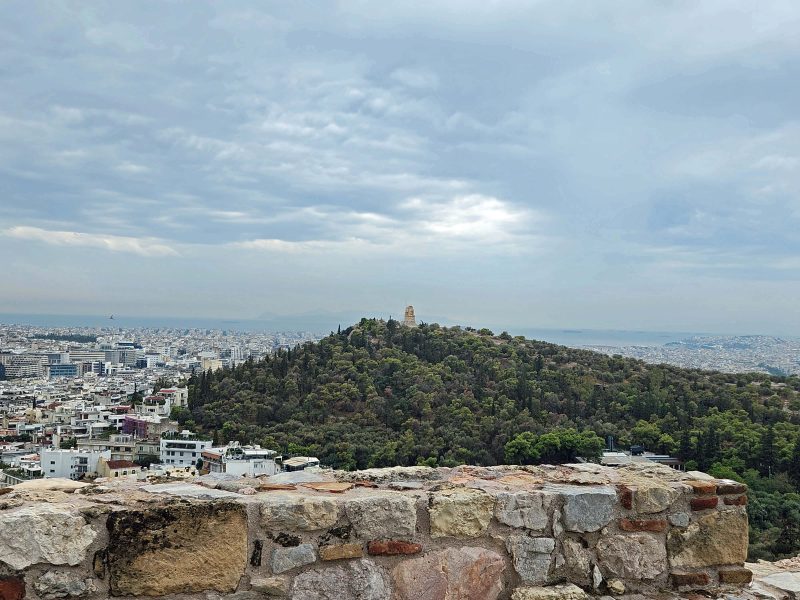
Following our time at The Acropolis, we had a brief city tour of Athens and passed the Panathenaic Stadium. The stadium was originally built as a racecourse in the 6th century BC and hosted the Panathenaic Games, held every four years to honor the goddess Athena. The Panathenaic Games were likely a rival to the Olympic Games, held in Olympia, Greece.
This site was originally built around 300 BC and has a long history too, so I’ll jump ahead to the late 19th century. The Greek government sponsored a refurbishment of the stadium prior to the first modern Olympics in 1896. The opening and closing ceremonies of the 1896 Olympics were held at this site and were viewed by a crowd of about 80,000 spectators. The stadium was used again for the 2004 Summer Olympics and for the 2011 Special Olympics World Summer Games. In my photo below, the stadium looks like an ice rink, but that’s rainwater. If you need proof, check out the people with umbrellas.
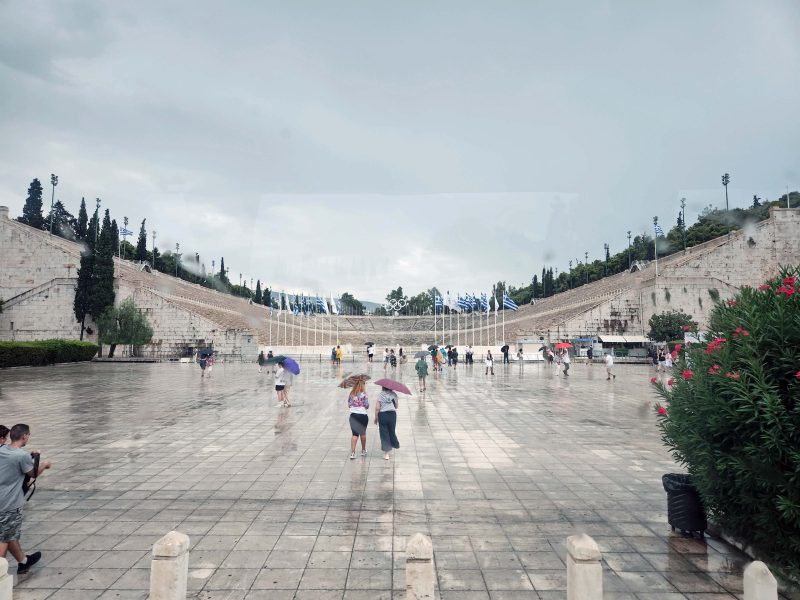
We and most of our travel group (excluding the die-hard shoppers) skipped the free time downtown and the shopping part of the day due to the continuing light showers. The next day, Ted and I (and many of our shipmates) visited the Plaka District, the oldest section of Athens, located at the base of The Acropolis. It’s described as “a village within the city, an island for those who don’t have time to visit the Greek Islands.” Most of the streets of the district are closed to automobile traffic and it’s a very nice neighborhood of homes, shops, and restaurants.

The weather was sunny and beautiful, and we enjoyed our time much more than we would have in the previous day’s rain. We even bought a small, zippered case, not because we really needed a zippered case (although we’ll use it), but because it was inexpensive and we wanted to change our €50 bills for lots of smaller denominations to use for tips. Mission accomplished!
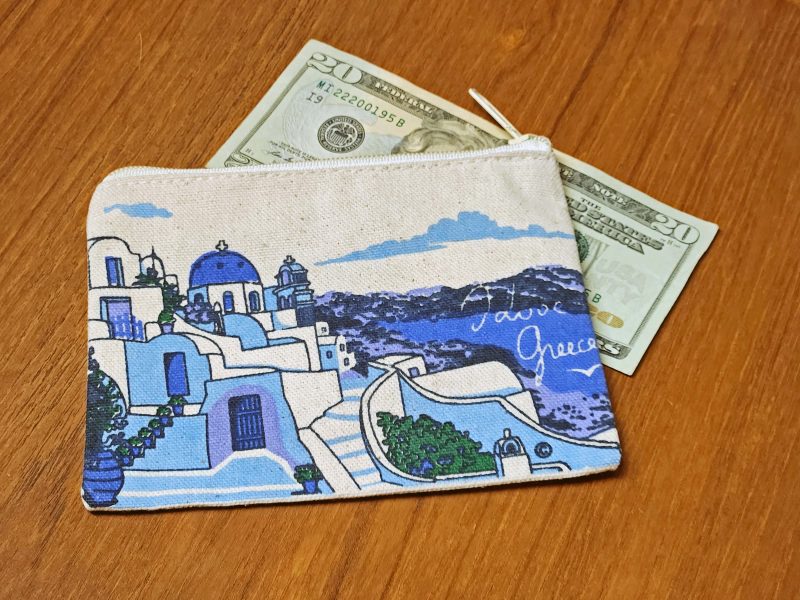
Dinner onboard featured Greek food tonight. I had moussaka for the first time. It’s basically a casserole similar to lasagna but layered with meat and vegetables instead of meat and pasta. Not surprisingly, “Cautious Ted” selected something more familiar to him for dinner, but when I told him the moussaka was delicious, and when he didn’t see any signs of me dying from eating it, he tried it and agreed that it was very good.